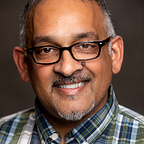Friendship: The New Social Endpoint For Teaching Mathematics
Why teach mathematics?
A generation or two ago, the answer to this question would have been rooted in supporting the transmission of the practicality of learning mathematics. To help students learn the prerequisite math that professions might demand. There was a steely coldness to this type of delivery of mathematics. The only posters for mathematics were often the ones outside the guidance office — trumpeting the vast array of careers that involved studying mathematics. I am sure these posters still exist today.
But the bar for mathematics has been getting raised, especially over the last few years, as to trying to find the deepest reasons for teaching and learning mathematics. The democratization of information and transparency of communication has been one of the reasons to bring an urgency to mathematics’ largest purpose.
So much has changed since the birth of social media over a decade ago. And, only until recently, has it been documented in an academic/research kind of way. The person who has been spearheading this analysis — since the last decade — has been Rachel Botsman. Her TED Talk, The Currency of the New Economy is Trust, with 3.5 million views, spoke confidently about a new social climate that hearkened back to the tribalism/group dynamics that started the human race hundreds of thousands years ago.
Very few have been immune from this shift trust — from trusting institutions to trusting strangers. While there have been many nuggets of wisdom from Botsman that have resonated with me, the one that has impacted how/why I think about mathematics now has been this one:
25 years ago we met people to new business. Now we do business to meet new people.
Rachel Botsman
A few years — almost subconsciously — I started sending send friend requests to people who “liked” my posts on some Facebook math forums like Jo Boaler’s How To Learn Math group, run by Karen Wootton. What I think I was doing was wanting to connect to people who affirmed some closely-held math ideas that I had shared. My writing has always been personal. So, if there was some resonance from “strangers” about perhaps my deepest thoughts about mathematics, then maybe we should connect. Now, keep in mind, all of this was happening in this Age of Trust that was fast becoming the dominant trait/currency in the new century. So, I am sure that had a large influence in how I started reaching out — in an oblivious, but not-so-random nature — to math folks all over…the world!
But, here is the most crucial part: I was reaching out to hopefully, in a kind of you never know mentality, to actually meet them — to continue the online relationships to offline friendships. Little did I know, but I was behaving in exactly the type of behavior that Rachel Botsman was documenting and talking/writing about — that I was developing my own kind of mathematical trust.
Today, two years after I started this leap of trust, I have physically met many kindred math spirits — with many more to come — after I had innocently struck up social media connections through Facebook or Twitter.
So, the timing seemed uncanny when Matt Larson, President of NCTM, published a wonderful article entitled Why Teach Mathematics? Upfront in the article, it mentioned Francis Su(past President of MAA) and his thoughts on the importance of this question — as it will greatly determine who will learn it, and how/why we will teach it in the coming years.
The first time I met Francis Su was when he invited me to dinner in Rockridge, California. Neither of us live there. I live in Toronto and he lives in Pasadena. The geographic planets lined up for both of us to be in the area in December 2017. Su is one of many examples of where preliminary online connections merged with the Botsman’s Conduit of Trust and fostered a mutual desire to meet — in our case, to discuss rich mathematical ideas over rich Thai cuisine in the remoteness and randomness of Northern California.
When my book came out last August, I sent Francis two copies. One for himself, and one for Christopher, the inmate who was an inspiration for Francis’ outgoing speech as MAA President back in January 2017. Over dinner we talked about the challenges of getting the book in the hands of Christopher. As we ate our delicious dinner in the Californian dusk, I often had to remind myself — how did I get here having dinner with Francis Su?
The easy answer would be that I wrote a book. But, a book is just a formal casing of words that has been accepted by a publisher. It is the words and intentions of the book that bear deeper examination.
For me, to get back to Matt Larson’s “Why Teach Math” question and reference Rachel Botstman’s “Trust Is The New Currency of the 21st Century”, mathematics serves as rich portal to understand and learn about another human being. To trust each other implies the seeds and budding flowers of friendship. I believe the greatest mathematical ideas and innovations will sprout with connections which inextricably weave trust and friendship together.
The deeper the mathematical ideas being shared, then perhaps deeper the connections/friendship. We are in such a vibrant time of sharing ideas — sometimes too many and too fast — that it would seem that mathematics has a critical role to play in defining how and why we meet. That is why when NCTM invited me to present under the strand Emerging Issues and Hot Topics in Washington, I knew exactly what my workshop/presentation would be about:
25 years ago, maybe we met people to do new mathematics. Now? Do we do mathematics to meet new people…?
I hope to meet many new people in April! I trust this to happen forever now…
